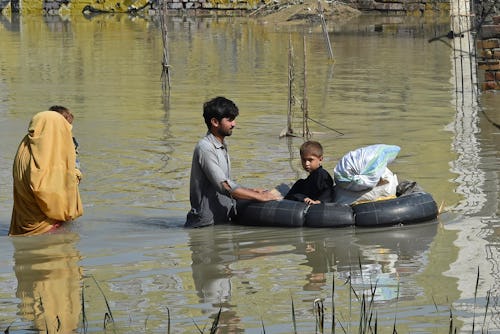The monsoon destruction in Pakistan right now is climate inequality laid bare
Industrialized nations have led the warming of our planet. But developing ones will pay the price.

In June, heavy monsoons started hitting Pakistan. They have yet to let up. Nearly two months later, the onslaught of rainwater has caused mass flooding that has tragically taken the lives of more than 1,000 people — including hundreds of children. The ongoing devastation from the event that Pakistan’s climate change minister Sherry Rehman has called “the monster monsoon of the decade” is one of the starkest and most troubling examples of just how destructive, disruptive, and unjust climate change can be.
One way to understand just how bad this monsoon season has been for Pakistan is through sheer numbers. More than 1,000 deaths from flash floods and related destruction — including nearly 350 children — is devastating. Another 1,500 people have suffered injuries, according to tallies from the country’s National Disaster Management Authority. That list grows every day, including a horrific 24-hour period over the past weekend when 119 people died.
Currently, more than 300,000 people are living in temporary camps due to rain and floods. The province of Sindh has requested another 1 million tents to house displaced people. An estimated 33 million people have been affected by these monsoons — more than 1 out of every 10 people in the country of 220 million.
Perhaps more jarring than the numbers are the images that have come out of Pakistan over the last few weeks. Pictures have emerged of the streets filling with sewage water as the septic systems are overwhelmed, bridges getting buried by raising water levels, entire buildings being swept up in the rolling tides and getting carried away. Each image is more harrowing than the last, as Pakistanis struggle to protect themselves from the devastation being brought right to their doors.
There is little mistaking what is happening in Pakistan right now: It’s climate change. “Pakistan is living through a serious climate catastrophe, one of the hardest in the decade,” Rehman said in a video. “We are, at the moment, at the ground zero of the frontline of extreme weather events in an unrelenting cascade of heat waves, forest fires, flash floods, multiple glacial lake outbursts, flood events, and now the monster monsoon of the decade is wreaking nonstop havoc throughout the country.”
What has happened in Pakistan over the last two months is something of a perfect storm of climate impacts coming together all at once. The nation has experienced significantly more rainfall than usual, already accumulating more than 2.5 times its annual average. It has also experienced significantly hotter temperatures than normal prior to these rains, which has contributed to the melting of the nation’s glaciers — leading to even more water flooding the streets.
Pakistan is unquestionably receiving the worst effects of our ongoing climate crisis at the moment, reinforcing the reality that it is developing nations without the infrastructure or resources to protect against these impacts that will feel it the most, despite the fact that the warming globe is mostly the work of industrialized nations. Still, no place will fully escape climate change. The U.S. is in the midst of its own ongoing extreme weather events, including out-of-control wildfires and floods. This is what our world will look like without action to curb climate change, and the window for addressing it is closing quick.